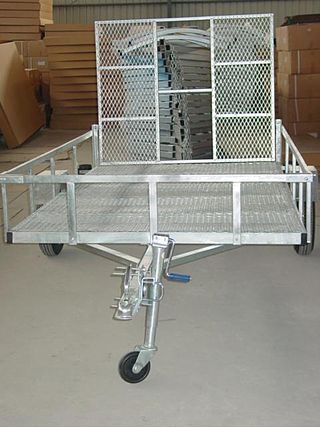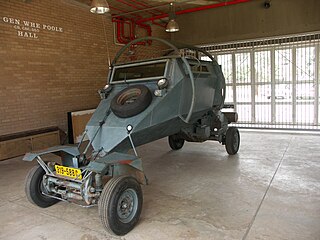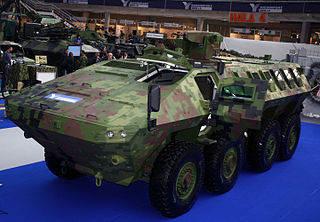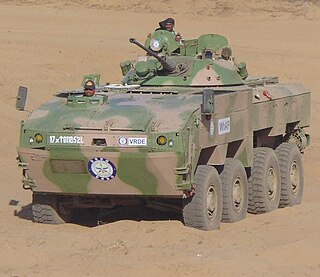
A semi-trailer truck, is the combination of a tractor unit and one or more semi-trailers to carry freight. A semi-trailer attaches to the tractor with a type of hitch called a fifth wheel.

The BMP-1 is a Soviet amphibious tracked infantry fighting vehicle that has been in service from 1966 to the present. BMP stands for Boyevaya Mashina Pyekhoty 1, meaning "infantry fighting vehicle, 1st serial model". The BMP-1 was the first mass-produced infantry fighting vehicle (IFV) of the Soviet Union. It was called the M-1967, BMP and BMP-76PB by NATO before its correct designation was known.

The Casspir is a Mine-resistant ambush protected vehicle that has been in use in South Africa since the 1980s. It is a four-wheeled, four-wheel drive vehicle, used for transport of troops. It can hold a crew of two, plus 12 additional soldiers and associated equipment. The Casspir was unique in design when launched, providing for passive mine defence. The main armoured steel body of the vehicle is raised high above the ground, so when a mine is detonated, the explosion is less likely to damage the crew compartment and kill the occupants. The cross-section of the hull is V-shaped, directing the force of the explosion outwards, further protecting the occupants.

The Mamba is a South African armoured personnel carrier designed for internal security purposes. It was developed during the late 1980s to replace the Buffel in service with the South African military and security forces. The first models were built on a 4X2 Toyota Dyna chassis, which was subsequently replaced in production around 1994 by a more reliable Unimog chassis. All marks of the Mamba were designed to be mine-resistant and blastproof.

The Buffel is an infantry mobility vehicle used by the South African Defence Force during the South African Border War. The Buffel was also used as an armoured fighting vehicle and proved itself in this role. It replaced the older Bedford RL-based Hippo APC and itself was replaced by the Mamba from 1995 in South Africa, but remains in use elsewhere, notably Sri Lanka.

A trailer is an unpowered vehicle towed by a powered vehicle. It is commonly used for the transport of goods and materials.

A semi-trailer is a trailer without a front axle. The combination of a semi-trailer and a tractor truck is called a semi-trailer truck.

An infantry mobility vehicle (IMV) is a wheeled armored personnel carrier (APC) serving as a military patrol, reconnaissance or security vehicle. Examples include the ATF Dingo, Iveco LMV, Oshkosh M-ATV, AMZ Dzik, AMZ Tur, Mungo ESK, and Bushmaster IMV. This term also applies to Mine-Resistant Ambush Protected (MRAP) vehicles.

The Tatra 148 was a truck produced in Czechoslovakia by the Tatra company.

The GFF4, previously KMW Grizzly, is a medium weight MRAP armored personnel carrier, developed by Krauss-Maffei Wegmann (KMW), designed for operation with the German Army based on the 6x6 Trakker chassis from Iveco adapted to meet the needs of the German Army. It is being developed under the direction of the German Ministry of Defence Federal Office of Defense Technology and Procurement. The GFF4 is designed to meet the German Army's "Class 4" protected command and role-specific vehicles, with a gross vehicle weight of 25 tons, and transportable on the Airbus A400M aircraft. Currently, the German Army could use only the smaller 12.5 ton ATF Dingo 2 or the 33 ton Boxer MRAV.

The Tatra 138 was a truck produced in Czechoslovakia by the Tatra company. The immediate successor to the Tatra 111, the model introduced a number of new features while continuing the evolution of Tatra concept. The truck was produced from 1959 to 1971.

The Type 96 Wheeled Armored Personnel Carrier is an armoured vehicle that entered service with Japan in 1996, manufactured by Komatsu. This vehicle complements the existing fleet of tracked Type 73 Armored Personnel Carriers already in service with plans to eventually replace it.

The Fahd is a 4x4 Egyptian armored personnel carrier, designed to fit the requirements of the Egyptian Military. It replaced older APCs in Egyptian service such as the BTR-40, and the Walid. It has been used by the United Nations.

The Leopard Security Vehicle is an unusual land-mine protected APC used by the Rhodesian government and civilian population during the 1964–1979 Rhodesian Bush War. It offered basic but necessary protection against mine attack through the use of a V-hull.
Windhoeker Maschinenfabrik (WMF) is a Namibian defense contractor located in Windhoek, Namibia and operated by the Namibian Defence Force. WMF designs and manufactures monocoque V-hull armoured combat vehicles. WMF is responsible for the armoured bodywork fabrication while engines, transmissions and axles are built by MAN.

The LAZAR is a family of multi-role armoured personnel carriers, designed for various applications and missions, designed and developed by Yugoimport-SDPR. There are 3 versions of Lazar family of armoured vehicles: Lazar 1, Lazar 2, and Lazar 3.

The TATA Kestrel, also known as the IPMV , is a family of armoured personnel carriers developed by Tata Advanced Systems and the Defence Research and Development Organisation (DRDO). It was developed to replace Soviet-era BMP-1 and BMP-2 and APCs in service with the Indian Army.

The SBA-60K2 Bulat armored personnel carrier (APC) was developed jointly by Kamaz and Zaschita corporation as a private venture. Development of this vehicle commenced in 2010 and was completed by 2013. It is a further 6x6 development of the earlier BPM-97 4x4 wheeled mine-resistant, ambush protected (MRAP) vehicle. Russia currently employs 15 Bulat vehicles received in late 2014, and ordered a new batch of further 50 vehicles from the Russian manufacturer Zashcita.

The IAG Guardian is a United Arab Emirates-made armored personnel vehicle. It was developed by the International Armored Group company. It's available in 4x4 and 6x6 configurations. This vehicle has been used in the Middle East conflict and has been marked as battle proven to participate in low intensity conflicts.

The SAMIL 50 is a 4x4 6-ton (load) truck.




















